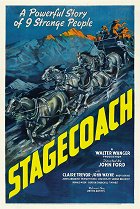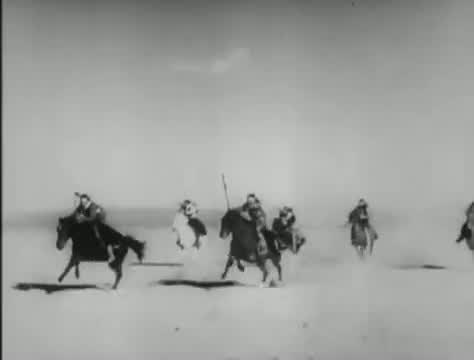Directed by:
John FordCinematography:
Bert GlennonCast:
Claire Trevor, John Wayne, Andy Devine, John Carradine, Thomas Mitchell, Louise Platt, George Bancroft, Donald Meek, Berton Churchill, Tim Holt, Tom Tyler (more)Plots(1)
With rumors in the air of a possible Apache attack, a motley group of travelers in a small New Mexico town board the Overland Stage bound for Lordsburg. Among them are the pregnant Lucy Mallory (Louise Platt); timid liquor salesman Peacock (Donald Meek); Hatfield, an aloof gambler (John Carradine); Gatewood (Berton Churchill), a pompous, embezzling banker; and two who have been exiled from town, alcoholic Doc Boone (Thomas Mitchell) and Dallas (Clair Trevor), a lady of the evening. Along the trail, they pick up the Ringo Kid (John Wayne), an outlaw who's escaped from prison to take revenge on the Plummer brothers for destroying his family and framing him for murder. As their journey progresses, the hypocrisy of the supposedly respectable passengers becomes clear, and it's the tainted outsiders who display courage and humanity. (official distributor synopsis)
(more)Reviews (4)
If anything puts the brakes on this ensemble western packed with everything a classic western should contain (Monument Valley, Indians, a shootout on the street), it’s a stagecoach stuffed with everything that the United States represented before the war. Though this microcosm of society enables Ford to characterise Kid as a self-reliant individualist standing outside the established social structures and, at the same time, to expand on his favourite theme of the birth of the American nation, the relationships between the characters are not well depicted in the Maupassant-esque comedy of morals and their “resolution” through the somewhat unfair use of a deus ex machina in the form of a band of savage Indians (who, unlike in The Searchers, are nothing more than an obstacle on the way to a civilised society). However, a few sardonic melodramatic interpolations and funny flashes of Ford’s humour are trampled into the ground during a long action scene with an example of unmistakably first-class filmmaking. The back projections and exterior shots with stunts are so skilfully combined that the transitions between the realistic and “artificial” environments are not jarring and the sequence unfolds at such a pace that you gladly forgive Ford for the baffling axle crossing. Perhaps it is a pity that not only the socio-critical dimension of the film remains in the shadow of this magnificent sequence, but so does the brilliant direction of the introductory part. Ford directs Stagecoach partially as a silent film. He mostly relies on static shots; instead of words, he lets the looks that the characters exchange do the talking and those looks thus have even greater storytelling value, which is not diminished by the details and other stylistic revivals in the film (the introduction of Wayne’s character is unforgettable thanks to the unique use of a swift approach of the camera). Every cut, every change in the size of the shot has its justification in Ford’s expressive economy. The style does not needlessly draw attention to itself; from the depth of the composed shots (which evidently had a strong influence on Citizen Kane), we learn only what is necessary for the plot structure. The clarity and comprehensibility of the narrative seem completely natural, which is due not only to the distinctiveness of Ford's direction, but also the difficulty of expressing it in words. Try to describe something invisible. Even though its qualities may not seem so obvious to you, Stagecoach remains a milestone of cinema. It is the film that started the revival of the western genre and took a B-list actor with rigid expressions and statuesque poses and turned him into an immortal film icon. 85%
()
Well outlined characters. Unfortunately they remained at the outline, which would work in a classic “shootout" western or conversational comedy, but not in a movie based on characters and friction between them. All the character development involves is whether or not this one or that one would survive. But was isn’t missing is good pace and good casting and so the only thing spoiling this is the Wayne storyline. For one thing, it makes the movie unnecessarily long-winded, plus it isn’t humanly possible to believe Duke’s desperado eaten up inside with desire for revenge; in any role he plays, he remains “only" John Wayne. Sometimes it fits, but here it doesn’t.
()
It's a classic western, though nothing happens for too long and the characters of the passengers, which are clear from the moment they enter the stage (drunkard: good guy, whiskey dealer: good guy, wagoner: fool, sheriff: honest guy, John Wayne: John Wayne), as well the relationships among them, which are more or less unimportant in the end. The visuals, however, are beautiful, Ford has the basic western motifs in a firm hand, and the stagecoach ambush by a band of Indians is one of his best ever. Undoubtedly a well-deserved legend status, but only for a specific audience. 60%
()
My journey through classic Westerns continues, and this time I ventured into the past. "The Raid" is an old Western with John Wayne from a time when this veteran was still a young man. John Ford was responsible for directing, and it is evident that this man truly deserved his reputation and his four Oscars. I know why I always measure everything against the Oscars... But there is no other way. They are the highest accolade that a film or its creators can receive. The Oscars are truly an event, even more so when creators outside of America are nominated. That has been happening mainly in recent years, when a Frenchman could win last year. John Ford made a purely American film, and it is clear that American Westerns and spaghetti Westerns are definitely something different. They can be compared, but differences can also be seen. Firstly, there are Indians here. In spaghetti Westerns, there are mainly Mexicans, but that is also due to my ignorance. The main thing is that the Wild West looks truly like the Wild West here. There are stagecoaches, wooden villages, the Rocky Mountains stretching as far as the eye can see; this is simply the real America and not an environment that looks more like a desert. Cowboys are cowboys in all Westerns, but there is only one John Wayne. He does not play a completely positive character here, but that gradually changes. The stagecoach is moving, and the people sitting in it are about to get to know each other. The finale is classic American, but before we get there, we witness a great ride that is crowned with truly spectacular shootouts. An excellent Western that has drawn me to American cinema. There will definitely be more of them. More: http://www.filmovy-denik.cz/2013/01/divosi-10-years-divoka-stvoreni-lets.html
()

